A near-universal and perhaps natural aspect of man’s affairs has been the acknowledgement and recognition of those who embody and exemplify “courage”. Awards granted for this quality have long existed, and, though highly varied in terms of appearance and the criteria for their bestowal, symbolize and represent – whether by name alone, or through recognition in popular culture – a country’s identity and perhaps its very ethos. This is particularly so for military awards, which by definition connote recognition of risk, danger, and the potential for an often irrevocable level sacrifice.
One such award is the United Kingdom’s Victoria Cross, the “highest military decoration awarded for valour ‘in the face of the enemy’ to members of the armed forces.” Instituted in January of 1856, by February, 2015, 1,355 individual had received VCs
During the Second World War, the sole Jewish serviceman to have received this award was Petty Officer Thomas William Gould, Royal Navy, Coxswain of the submarine HMS Thrasher. (During the First World War, five Jews – Capt. Robert Gee, 2 Lt. Leonard Keyzor, Lt. Frank Alexander de Pass (KIA 11/25/14), Cpl. Issy Smith, and Pvt. Jack White – were granted the VC.)
 P/O Gould and fellow crewman Lieutenant Peter S.W. Roberts received the VC for their action during a circumstance that – while not necessarily involving immediate and active combat with enemy forces – nevertheless entailed the solid possibility of death, eventuating in the survival of their vessel and fellow crewmen, let alone themselves: They removed two unexploded aerial bombs that had become lodged within their submarine, the removal of one of which necessitated a tortuous and lengthy extraction – in darkness – from within the very narrow confines of the space between the Thrasher’s outer casing and pressure hull.
P/O Gould and fellow crewman Lieutenant Peter S.W. Roberts received the VC for their action during a circumstance that – while not necessarily involving immediate and active combat with enemy forces – nevertheless entailed the solid possibility of death, eventuating in the survival of their vessel and fellow crewmen, let alone themselves: They removed two unexploded aerial bombs that had become lodged within their submarine, the removal of one of which necessitated a tortuous and lengthy extraction – in darkness – from within the very narrow confines of the space between the Thrasher’s outer casing and pressure hull.
Given the abundance and ready availability of information about Gould and Roberts’ action, rather than fully recapitulate the story, a well-written account of events aboard the Thrasher in mid-February 1942, from Cranston Military Prints, is presented below:
Thomas William Gould, submariner: born Dover, Kent 28 December 1914; VC 1942; married 1941 Phyllis Eldridge (died 1985; one son); died Peterborough, Cambridgeshire 6 December 2001.
For the longest 40 minutes of his life, Petty Officer Tommy Gould lay on his back clutching an unexploded bomb, while being pulled by his shoulders through the casing of the submarine Thrasher. He was aware throughout this nerve-racking task not only of strange noises emanating from the bomb, but that in the event of an enemy attack the submarine would have to crash-dive and both men would be drowned. For this remarkable feat of courage, along with Lieutenant Peter Roberts, Gould was awarded a Victoria Cross: the only one to be awarded to a Jewish serviceman in the Second World War.
On 16th February 1942, under the command of Lt H.S. Mackenzie, Thrasher sank a supply ship off the north coast of Crete but was immediately attacked by enemy aircraft and heavily depth-charged by the escorting anti-submarine vessels for three and a half hours. Through skillful work by its captain, Thrasher managed to survive the attack but while it was on the surface that night recharging its batteries, an unusual banging noise was heard. This proved to be two bombs, each about three feet long, six inches in diameter and weighing 100 lb, that were lying on the submarine’s casing just in front of the four-inch gun mounting. Roberts and Gould volunteered to remove the bombs. Gould, as Coxswain, was in charge of everything involved with the casing which enclosed a tangle of pipes, wires and other gear. When they reached the first bomb they wrapped it in an old potato sack and tied it with rope. They cautiously manhandled it forward to the bows where they dropped it overboard. As they did so, Thrasher went full astern to get clear. The second bomb proved to be far more difficult. After an examination of the casing the two men found a jagged hole in the metal; inside was the bomb, resting on top of the pressure hull. There was no practical way to recover the bomb through the hole it had made. The only way was through a hinged metal grating trap-door.
Gould was to recall: To get to the bomb we had to wiggle forward through the outer casing. In that confined space there were angle irons to hold the superstructure up, battery ventilators and drop bollards as well. When we got through, I saw that it was another heavy bomb, about 100 lb. Then began a nightmarish journey back through the casing, which at points gave only two feet clearance from the hull: I picked up the bomb and passed it through to Roberts. I then laid on my back with the bomb on my stomach, and held on to it while he laid on his stomach with his head to my head pulling me by my shoulders. It was pitch dark and the bomb was making this ticking noise while the submarine was being buffeted by the waves. Also at the back of their minds was the thought that if the submarine was attacked, the captain would have no option but to dive, the unpressurised casing would fill up with water and the two men would drown. After a grueling 40 minutes they got to the grating. The bomb was then passed up to a sub-lieutenant who was waiting on the forecasing. The bomb was wrapped in sacking and gingerly lowered over the side by ropes. When we knew it was on the surface of the water we let it go, heaving lines as well. Then we ducked and waited for the explosion, but nothing happened – it obviously could not have been primed.
The Thrasher’s combat history (derived from documents at the National Archives, Kew) can be found at UBoatNet, from which details of the events of 16-17 February 1942 are presented below:
16 Feb 1942
HMS Thrasher (Lt. H.S. Mackenzie, RN) makes a torpedo attack on the German merchant Arkadia (1756 GRT, built 1927) off Suda Bay, Crete, Greece. All torpedoes fired however missed their target.
(All times are zone -2)
0413 hours – Sighted three darkened ships bearing 255°, distance 5 nautical miles. Altered course towards. Thrasher is however unable to get into an attack position
0520 hours – Proceeded towards Suda Bay
0730 hours – Dived in position 060°, Cape Drepano distance 11,5 nautical miles
0855 hours – A small 1000 ton merchant ship escorted by a minesweeper or motor launch was sighted bearing 200°, distance 5 nautical miles. Their course was 120 and they had just left Suda Bay. Closed at speed to within 6000 yards. Could not get closed and at the range Lt. MacKenzie did not consider it worth firing torpedoes so the attack was abandoned
0945 hours – Sighted one small patrol vessel in the entrance to Suda Bay
1020 hours – Saw one motor launch approaching from Suda Bay. It passed 2 nautical miles astern and disappeared at about 12 knots in a north-easterly direction
1050 hours – Saw one M.A.S. boat leaving Suda Bay at high speed
1055 hours – The M.A.S. boat stopped about 3000 yards away bearing 240°. Thrasher went deep and retired to the Eastward
1150 hours – Sighted a large two-masted schooner entering Suda Bay
1155 hours – Sighted one merchant vessel bearing 060°. Altered course and started an attack. The merchant ship was about 3000 tons and was deeply laden. Five escorts were seen, one ahead, one on each beam and one on each quarter. Three of the escorts were transmitting on Asdic. Also one or two aircraft were circling overhead
1234 hours – Fired the first of a salvo of four torpedoes from 2000 yards. A few seconds after firing the first torpedo a muffled explosion shook the submarine considerably, probably a bomb dropped by an aircraft. Less than a minute later machine gun bullets were heard striking the water. Almost three minutes after firing the first torpedo a loud distant explosion was hear followed ten seconds later by another. This might have been the torpedoes exploding or depth charges. Thrasher dived to 270 feet and retired to the Northward
1245 hours – The first of a total of 33 depth charges was dropped. Most were too close for comfort. Minor damage was caused
1430 hours – While at periscope depth three A/S vessels were seen to be still hunting. Aircraft were also seen. Thrasher went deep again and continued to retire while reloading the torpedo tubes
1545 hours – Came to periscope depth again. Nothing in sight
1906 hours – Surfaced. (7)
17 Feb 1942
Two bombs were removed from the deck and the casing of HMS Thrasher. These bombs were dropped by an aircraft during the attack on the merchant yesterday.
(all times are zone -2)
0150 hours – Discovered a large hole in the side of the gun platform and one unexploded bomb of about 100 lbs laying on the fore casing just forward of the gun. This bomb had only a small portion of its tail attached to it, preventing it from rolling off the casing
0240 hours – Went to full speed astern and lowered into the water to let go the bomb over the bows. A further examination of the casing revealed another bomb inside the casing lying on the pressure hull just forward of the gun support. This bomb had to be dragged for 20 feet through the casing before it could be get out and dropped over the side at 0330 hours. This was accomplished by first lieutenant Lt. P.S.W. Roberts, RN and petty officer T.W. Gould. They both received the Victoria Cross for this.
0335 hours – Set course towards Cape Matapan
0623 hours – Dived. Closed to within five nautical miles from Cape Matapan and then set course to the Westward
1926 hours – Surfaced. (7)
______________________________
As for the Thrasher herself? She was a T (“Triton”) class diesel-electric submarine, the design of which dated from the 1930s. One of fifty such vessels constructed before and during the Second World War, she was built by Cammell Laird & Co. Limited, of Birkenhead, laid down on November 14, 1939 and launched a little over a year later, on November 28, 1940. Commissioned on May 14, 1941, she survived the war to be scrapped in Wales in March of 1947. She accounted for 20,000 tons of shipping sunk during the Mediterranean Campaign, and, commencing early 1945, a further 20 sailing vessels and coasters in the Pacific Theater.
According to UBoatNet, she had seven commanders from very early 1941 through late 1945: Lt. P.J. Cowell, DSC; Lt. Hugh S. MacKenzie; Lt. Cdr. Arthur R. Hezlet, DSC; Lt. Hugo R.B. Newton, DSC; Lt. Cdr. John W. McCoy, DSC; Lt. Newton (once more); and Lt. Michael F.R. Ainslie, DSO, DSC.
______________________________
Two illustrations of the Thrasher follow.
This color painting of the Thrasher, by John Pettit, appropriately entitled “Thrasher Returning from patrol off Crete in March of 1942”, is available at Cranston Military Prints.
 The Thrasher underway. (Photograph FL 9745 from the Imperial War Museum (collection no. 8308-29)).
The Thrasher underway. (Photograph FL 9745 from the Imperial War Museum (collection no. 8308-29)).
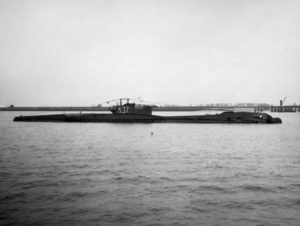 The emblem of the Thrasher, from the submarine’s Wikipedia entry, originally from RN Subs.
The emblem of the Thrasher, from the submarine’s Wikipedia entry, originally from RN Subs.
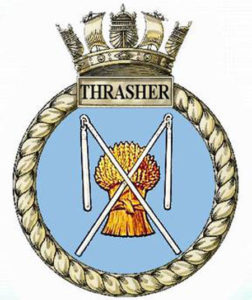 (Then) Lieutenant (late Captain, eventually Vice Admiral) Hugh Stirling MacKenzie, commander of the Thrasher from October 12, 1941, through March 3, 1943. Admiral MacKenzie’s oral history, encompassing his military career from 1939 through April of 1945 (in four segments cumulatively totaling approximately two hours) can be accessed at the Imperial War Museum.
(Then) Lieutenant (late Captain, eventually Vice Admiral) Hugh Stirling MacKenzie, commander of the Thrasher from October 12, 1941, through March 3, 1943. Admiral MacKenzie’s oral history, encompassing his military career from 1939 through April of 1945 (in four segments cumulatively totaling approximately two hours) can be accessed at the Imperial War Museum.
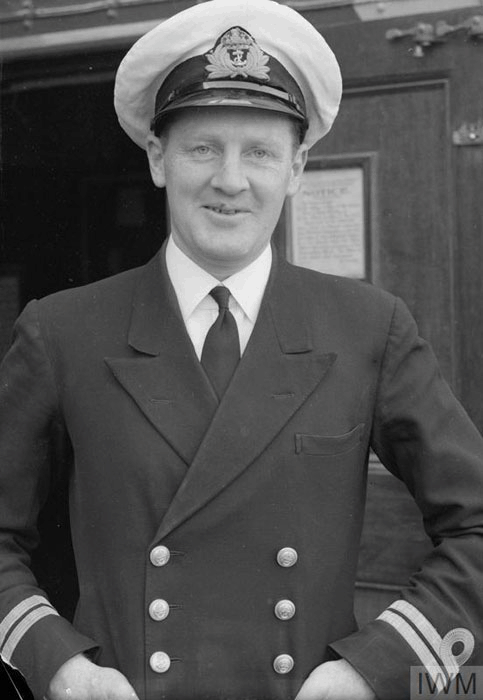 Lieutenant Peter S.W. Roberts, VC, DSC (from Royal Navy Submarine Museum Friends). Born in July of 1917 in Chesham Bois, Buckinghamshire, he died in December of 1979, at the age of 62. He is buried at Holy Cross Churchyard, at Newton Ferrers, in Devon.
Lieutenant Peter S.W. Roberts, VC, DSC (from Royal Navy Submarine Museum Friends). Born in July of 1917 in Chesham Bois, Buckinghamshire, he died in December of 1979, at the age of 62. He is buried at Holy Cross Churchyard, at Newton Ferrers, in Devon.
 ______________________________
______________________________
The Thrasher ended her eighth war patrol at Alexandria, Egypt, on 5 March, 1942. She remained at that location and Port Said until March 29, when she began her ninth patrol. On March , one day after her arrival at that city, damage incurred by the submarine was photographed by Lieutenant E.E. Allen, RN, with the resulting images showing external views of the rear section of the submarine, her conning tower, and, close-ups of the bomb penetration points. Four of these photographs (all four images being part of the Imperial War Museum’s collection) follow.
Photo A13572
“A wired view showing the hole in the conning tower of HMS Thrasher caused by a bomb which failed to explode after it was dropped from an enemy aircraft.”
 Photo A8711
Photo A8711
A: Where bomb penetrated the gun platform.
A1: The position where the bomb was discovered inside the casing.
B: Position where the second unexploded bomb was discovered lying on the casing, with the bomb represented by the tin can.
C: Petty Officer Gould, VC, standing in the casing-hatch through which bomb from A1 was dragged.
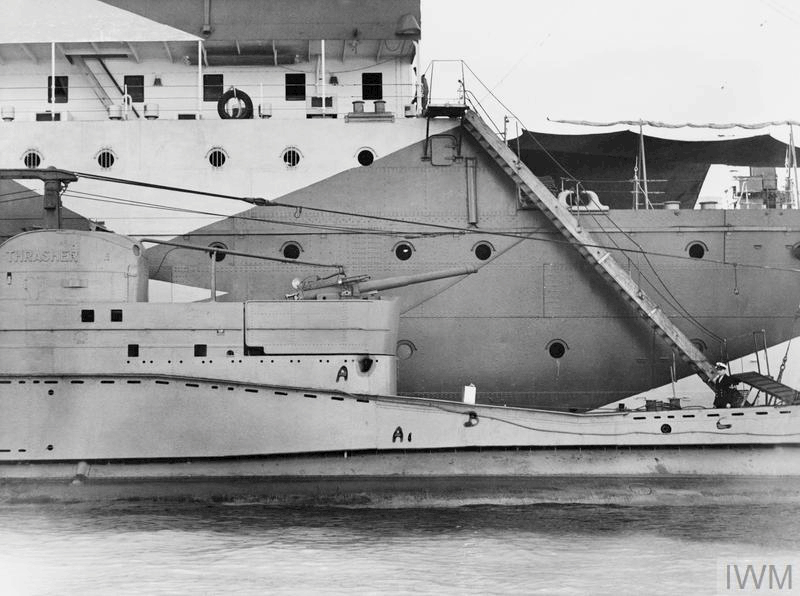 Photo A8710
Photo A8710
The Thrasher’s conning tower.
A: Where bomb penetrated the gun platform.
A1: The position where the bomb was discovered inside the casing.
B: Position where 2nd unexploded bomb was discovered lying on the casing, bomb represented by the tin can.
C: Petty Officer Gould, VC, standing in the casing-hatch through which bomb from A1 was dragged.
This web page presents two versions of photo A8710 – of differing contrast – made from the same negative (remember those purely physical things called “photographic negatives”?!).

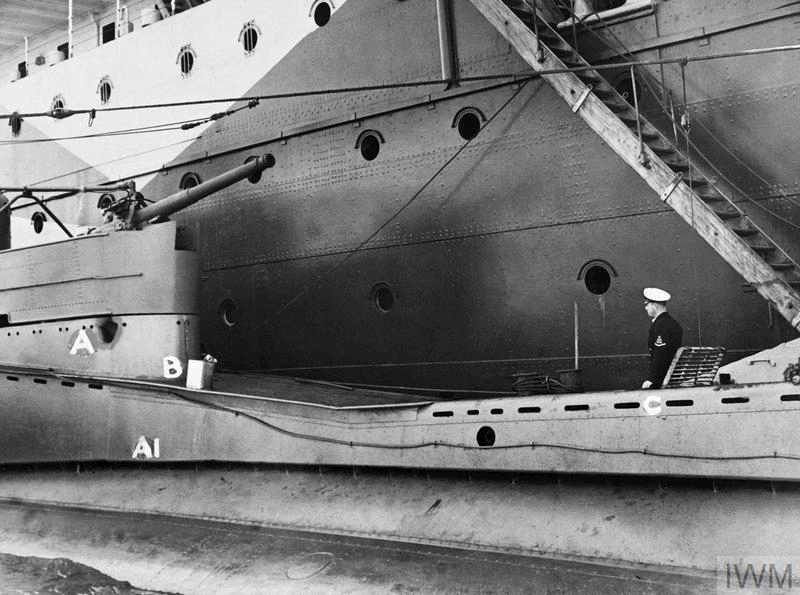 Photo A13569
Photo A13569
The bomb penetration hole in the Thrasher’s conning tower. This was left by the “first” and more easily (well, comparatively easily!) removed of the two bombs.
 ______________________________
______________________________
The Thrasher departed Gibraltar for the United Kingdom on 6 December 1942, arriving in Falmouth of the 14th of that month. She departed Falmouth for the submarine base at Portsmouth on the 17th, arriving at the latter on 18 December. The next day, 19 December, she departed Portsmouth for Sheerness, which was reached on 20 December. Between that date and the commencement of her 14th War Patrol on 6 August, 1943, she was located at various stations in the United Kingdom, conducting exercises, and, undergoing modifications to accept the loading and operation of Welman midget submarines.
______________________________
The Thrasher – or, to be more specific, the return of the Thrasher from her 13th War Patrol – appeared in film as well photographs. The submarine was featured in the British Pathé film “H.M. Submarine “Thrasher” (1943)”, and British Movietone News’ “H.M.S. ‘Thrasher’ Home From Triumphs”, both of which are comprised of the same stock, albeit the Pathé film being of far better quality. Though the film is undated, in light of the locations listed above, it was probably taken at Falmouth, Portsmouth, or Sheerness in mid-December of 1942.
Notably, the film includes very brief comments by Lt. MacKenzie, images of P/O Gould, and members of the Thrasher’s crew displaying a pennant denoting the submarine’s victories against enemy shipping, though the only crewmen specifically identified are Lt. MacKenzie and P/O Gould. The two screen captures below show Thrasher crewmen with the sub’s victory pennant.
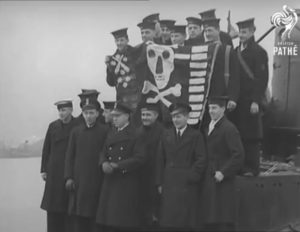
 Another image of members of the Thrasher’s crew, almost certainly taken on the same occasion, can be found at Finding Your Submarine Ancestor. (Could the original of this image have been a photographic “still” shot, rather than a frame from a film?)
Another image of members of the Thrasher’s crew, almost certainly taken on the same occasion, can be found at Finding Your Submarine Ancestor. (Could the original of this image have been a photographic “still” shot, rather than a frame from a film?)
 And, another image of the crew; again, also probably a “still” shot… At the flickr photostream of lossow.vamp, entitled “HMS Thrasher Crew, Dover, Kent 1944”, this image elicited comments by Ted McBale and thrasherlegacy (Jon Davison):
And, another image of the crew; again, also probably a “still” shot… At the flickr photostream of lossow.vamp, entitled “HMS Thrasher Crew, Dover, Kent 1944”, this image elicited comments by Ted McBale and thrasherlegacy (Jon Davison):
 Ted McBale: “GREAT crew GREAT boat. Saved my father [J. Bale] and some of his pals Agyll and Sutherland Highlanders from Limni Bay Crete on the night of 27/ 28 July sometime after the battle of Crete. Seventy eight souls were saved that night. I believe the Commander at that time was Lieutenant Commander Cowell. Petty Officer Gould became a driving instructor in peace time and sadly had to sell his V.C. to help ends meet. I believe he passed away in 2001. Ted Bale.”
Ted McBale: “GREAT crew GREAT boat. Saved my father [J. Bale] and some of his pals Agyll and Sutherland Highlanders from Limni Bay Crete on the night of 27/ 28 July sometime after the battle of Crete. Seventy eight souls were saved that night. I believe the Commander at that time was Lieutenant Commander Cowell. Petty Officer Gould became a driving instructor in peace time and sadly had to sell his V.C. to help ends meet. I believe he passed away in 2001. Ted Bale.”
Thrasherlegacy (Jon Davison): “My late father, George Davison is on the right holding the pennant. Knowing his cheeky nature, he is obviously doing ‘something’ with his right hand behind the pennant, to make the two crew smile like that! Dad passed away in 1997. I met some of the crew including PO Tommy Gould at a reunion in Stratford on Thames in the 1990s. Thanks Jon Davison.”
Close observation of the latter photo seems to show Lt. MacKenzie in the center of the image.
And lastly, a screen capture of P/O Gould standing before the Thrasher’s conning tower.
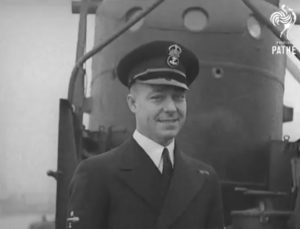 ______________________________
______________________________
Thus for the award; what of the man?
Ironically, though P/O Gould’s award of the VC was briefly noted in The Jewish Chronicle on July 13, 1945, two years earlier, another publication presented him in far more detail. The twenty-nine-year-old Petty Officer and his family were the subject of a photo essay in the March 13, 1943, issue of Parade – Middle East Weekly – Magazine. (Parade was the basis of an earlier blog post about the Auxiliary Territorial Service.)
All ten images from this article are presented below, with (transcribed) captions accompanying each photo.
The one consistent message that emanates from the photos – both intentionally, and naturally – is one of normalcy and continuity: “Life” – A child, family, comradery, and especially peaceful domesticity continue, amidst the challenges and material sacrifices caused by war. The pictures are certainly posed, but do project an air of spontaneity. The location of P/O Gould’s home, let alone other scenes (the local grocer and pub) are not given, but the mention of “St. Albans United Services Club” would suggest that the setting is indeed within that city: Saint Albans, in Hertfordshire.
Front Cover
“Thrasher V.C. Goes Home”: P/O Gould, his wife Phyllis, and their baby son Keith, out for a winter stroll.
 1
1
With his wife, son and wife’s parents, P.O. Gould, V.C., enjoys evening beside the fire.
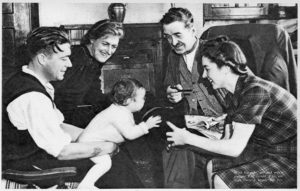 2
2
Mummy and daddy play with Keith on the floor; he is having the time of his life. Keith has great selection of toys – woolly animals, bricks, trolley, rattle, duck.
 3
3
Petty Officer Gould waits outside shop. Looks after baby while his wife collects the rations. Baby behaves well when left with Daddy. Shop shows all the familiar signs of peacetime.

This image is intriguing, for the placards within and outside the storefront advertise such items at Keens Pies, De Reszke something-or-other, and Typhoon Tea.
I had absolutely no knowledge of any of these products, and that’s where https://duckduckgo.com came in handy. It turns out that De Reszke was a cigarette brand, memorabilia of which now seems to be collectable, as shown in the image below (from WorthPoint) – displaying a sign seemingly identical, in shape and colors, to the sign before the grocery window.
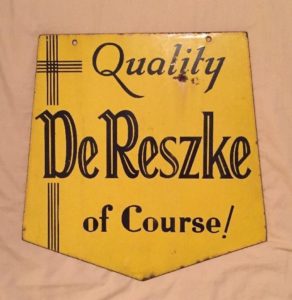 4
4
For first time Petty Officer Gould meets his son Keith, aged ten months. Baby appears more interested in the camera; but mummy seems very proud of them both.
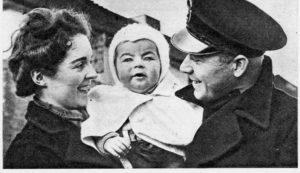 5
5
A talk over old times in the local. P.O. Gould has a pint with Mr. C.F. Edwins, a former sergeant-major of the Bedford Regiment.
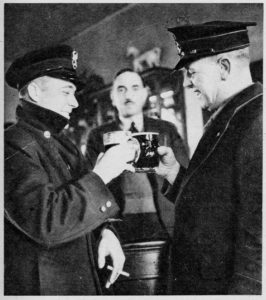 6
6
Members of St. Albans United Services Club for cadets waited for submarine hero to come home to open club, were determined he should perform ceremony. P.O. Gould inspects guard of honour of Sea Cadets.
 7
7
Inside the house too. P.O. Gould helps. Together he and his wife quickly polish off the washing up. Towel seems to indicate that he did the drying.
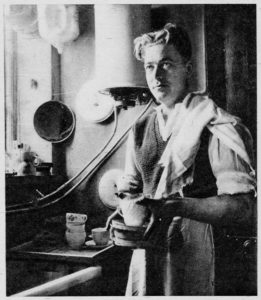 8
8
To the man always at home chores may be a bit of a bore, but in the months at sea P.O. Gould dreamed of the time he would be able to do odd jobs about the house. Now he is busy cleaning the windows.
 9
9
He plans ‘Dig for Victory’ campaign and turns over the garden with his wife’s help. Both of them find job a source of merriment. Mrs. Emily Aldridge, P.O. Gould’s mother-in-law, carries baby Keith and looks on. [Notably, the caption gives the maiden name of Tommy’s wife Phyllis as “Aldridge”, not “Eldridge”, as in other references.]
 10
10
The garden fence had needed painting for a long time, but had to wait until Petty Officer Gould had done more important jobs.
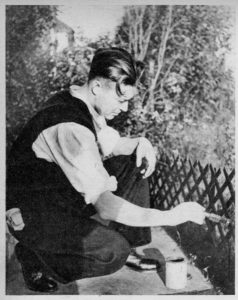 ______________________________
______________________________
Thus for the Victoria Cross: what of P/O Gould’s life, after the war?
Brief overviews of Tommy Gould’s post-award, post-war life are presented in his 2001 obituary, and, at Cranston Military Prints, the latter appearing below:
On 29 June 1943 Gould received his Victoria Cross from King George VI who commented, I bet it was cold. Gould’s father, Reuben, was lost in action in 1916 before Tommy was two years old.
Tommy Gould was educated at St James School, Dover, and joined the Royal Navy in 1933 and went into the submarine service three years later. During the war he experienced the horror of being trapped on the ocean floor in the Dutch East Indies as well as being bombed by the RAF off Alexandria. But Gould loved the camaraderie of submarine life and, after being invalided out of the Navy in 1945, maintained an interest in the Navy and with the Jewish community. In 1946 he was in the front row of the Jewish ex-servicemen’s march through London to protest against the government’s policy towards the Jews in Palestine. He became a Lieutenant with the Bromley branch of the Sea Cadets. For many years he was Chief Personnel Manager with Great Universal Stores. He was very proud to have been elected President of the International Submarine Association of Great Britain. He was also an active member of the Victoria and George Cross Association. Gould was a smart, dapper man who in his later years wore an impressive naval beard. His Victoria Cross was sold at Sotheby’s in 1987 for £48,400 and purchased by the Association of Jewish ex-servicemen. He passed away on 6th December 2001.
But, this seems not to have been the full story. As known through the annals of human experience – recounted in books; poetry; cinema; in fiction and non-fiction – there has never been a guaranteed correlation between military valor and “success” – in civilian life. (Then again, “success” is a quality rather subjective…) Perhaps Tommy Gould’s postwar life represented this, for his receipt of the VC may have become an impediment to employment. As recounted at RN Subs and elsewhere, “In May of 1965, Tommy Gould’s name was in the papers again, this time as “a VC on the dole”.
“He had lost his job as personnel manager because of “a clash of personalities” and remarked that he was finding his VC a liability.
“Incredible though it may seem, people in top management seem to shy away from me. I think it might be because they are afraid that a man with such a record could show too much embarrassing initiative. If it is the VC which is frightening people away from me I wish they would forget it. Those days are over.”
This would seem to be consistent with Ted McBale’s above comment – at flickr – that, “Petty Officer Gould became a driving instructor in peace time and sadly had to sell his V.C. to help ends meet.” Unfortunately, the above-mentioned 1965 news item recounting his postwar challenges is unavailable on the Internet. (Thankfully, the panopticon otherwise known as “Google” does not yet control all information. (Yet.)) Even the very title of the publication is unknown. Perhaps that article still exists somewhere; maybe on a roll of 35mm microfilm, in an as yet unknown archive, library, or repository.
Tommy Gould passed away in 2001 at the age of 86. FindAGrave lists his place of burial as the Peterborough Crematorium, in Cambridgeshire.
In the way of all men, his memory now belongs to the ages.
References
Thomas W. Gould
Biography (Military Art)
Biography (Royal Navy Subs)
Biography (Kent History Forum)
Obituary (The Guardian)
Obituary (The Telegraph)
Obituary (Independent)
Place of Commemoration / Burial (FindAGrave)
Photograph: Gould, Thomas W. and Roberts, Peter S.W. (Lieutenant PSW Roberts VC and Petty Officer T. Gould VC HSM Thrasher, Mediterranean 1942” (Friends of the Royal Navy Submarine Museum)
Peter S.W. Roberts
Biography – Peter Scawen Watkinson Roberts (Royal Navy Subs)
Biography – Peter Scawen Watkinson Roberts (FindAGrave)
Photograph: Gould, Thomas W. and Roberts, Peter S.W. (Lieutenant PSW Roberts VC and Petty Officer T. Gould VC HSM Thrasher, Mediterranean 1942” (Friends of the Royal Navy Submarine Museum)
Lieutenant Hugh Stirling MacKenzie
Biography (Wikipedia)
Biography (U-Boat Net)
Oral History (Imperial War Museum)
Obituary (The Herald (Scotland))
HMS Thrasher
Historical Profile (U-Boat Net)
Historical Profile (Royal Navy Subs)
Badge (Wikipedia)
Painting: “HMS Thrasher returning from patrol off Crete in March 1942” – Color Painting by John Pettit (Cranston Military Prints – Item DHM6106Y) (Military Art)
Photograph: “Underway” (Wikimedia Commons – Imperial War Museum (Image 8308-29))
Photograph: “HMS Thrasher Crew at Dover, Kent, 1944” (lossow.vamp photostream at Flicker)
Photograph of Thrasher Crew (Forces War Records – Finding Your Submarine Ancestor)
Photographs of damage incurred during evening of February 16-17, 1942 (Imperial War Museum)
Photo A13572 (IWM Collection 205146864)
Photo A8711 (IWM Collection 205142636)
Photo A8710 (IWM Collection 205142635)
Photo A13569 (IWM Collection 205146861)
Films
“HMS Thrasher Home From Triumphs” (British Movietone YouTube Channel)
“H.M. Submarine “Thrasher” (British Pathé YouTube Channel)
Miscellaneous
De Reszke Cigarette Sign (Worthpoint)
Victoria Cross (Wikipedia)
Jewish Victoria Cross Recipients (London Jews in the First World War)
VC * GC Association (VCGCA)
Book
Morris, Henry, and Halter, Hilary, We Will Remember Them – A Record of the Jews Who Died in the Armed Forces of the Crown, 1939-1945: An Addendum, AJEX, London, England, 1994 (Tommy Gould, pp. 90-91)
